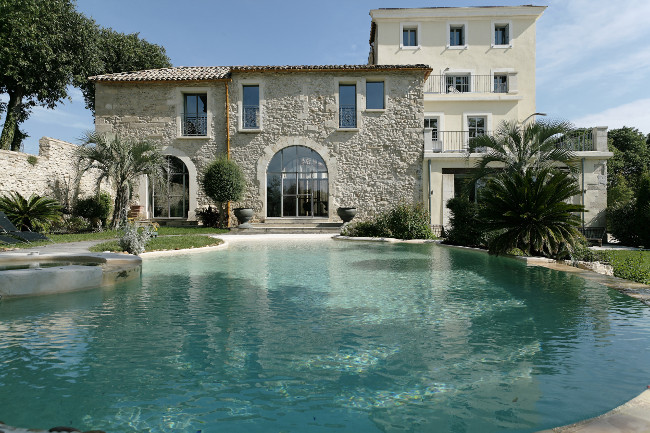Words by David Constable
Montpellier is a walkers city with stately boulevards, family-run bakeries and white-sand beaches on the doorstep. It is a sun-kissed city, an easy-going place with a small population (around 275,000 people). But things are heating up here; there’s a swell of new inhabitants and a colourful energy, thanks in large to a booming student population and the mayor’s fixation with grand flagship projects.
A dynamic city, Montpellier is a mix of elegant buildings, beautiful squares and grand hotels. Often overlooked for the bigger southern French metropolises of Toulouse and Nice, Montpellier is beginning to emerge from the shadow of its southern neighbours, ready to reveal its own particular charms.

Founded in the 10th century by the counts of Toulouse, the city became a prosperous trading port as well as a scholarly centre with Europe’s first medical school reportedly established here in the 12th century. Famous students include Nostradamus, who was expelled for being an apothecary – Montpellier’s dope-pusher of the day – and Rabelais, who is mostly remembered for his trifling satire and grotesque, bawdy jokes. As an established hub for academics, there are three Montpellier universities with nearly one third of the population being students. As such it is now the fastest growing city in France over the last half-century (as well as one of the most multicultural) more than doubling in size from 119,000 in 1962. At this rate, it is hot on the heels of Strasbourg as France’s seventh most populated city.
It was in the 60s that Montpellier also saw a significant influx of pieds-noir (Christian and Jewish people whose families had migrated from all parts of the Mediterranean to French Algeria) and Spanish exiles from Franco. From a poky provincial city on the Mediterranean coast, Montpellier swelled with it’s open-door policy and 300 days a year of sunshine. You can see the allure.

The airport is strategically well-placed, 8km away from the city, with regular flights from London and the major European cities. There’s a burgeoning music, sports and arts scene with the “Comédie du rire”, Festival of Extreme Sports and the upcoming Bruno Mars 24K World Tour rolling into town at the Park & Suites Arena. The city was also crowned as France’s second sportiest by L’Équipe newspaper, thanks to its diverse offering; from football, rugby and basketball to kiteboarding, martial arts and a wealth of interminable cycling routes; including a track that weaves and swerves past coastal lagoons to Palavas, a sleepy fishing port turned day-tripper resort. Spend five-minutes in The Place de la Comédie Square, the city’s focal point and foremost student hangout, and you’ll see everything from skateboarding to BMX-stunts to spontaneous reggae dancing.

For the culture vulture there is an array of museums and galleries – and, of course, the town’s stately Gothic Cathédrale Saint-Pierre de Montpellier – but unlike most southern towns of the region, you won’t find Roman remnants here. Instead, the works of French artists, architects and academics are fostered and celebrated, such as at The Musée Fabre (founded in 1825 by painter François-Xavier Fabre) which houses one of the country’s richest collections of European art; from Old Masters to Modern Movements, the collection represents the last 600 years of artistic activity in Europe. Highlights include paintings by Rubens and a portrait of Marseille-born artist Fréderic Bazille by a young Monet. For a more pedestrian collection of local-interest pieces, the Musée du Vieux Montpellier houses furniture, tapestries and antique weaponry and is worth a visit alone to see one of the few hôtels particuliers (private mansions) that are open to the public.
As a city famed for its resplendent buildings, it’s no surprise that Montpellier has some of the most spectacular chateaus and hôtels particuliers in all of France. Topping the list of historic, heritage-listed hotels is Domaine de Verchant, a 16th century stone chateau set amongst 17 hectares of its own vineyards and floral, fragrant gardens. Given its name by the Bishop of Montpellier, who gifted the estate to Pierre Verchant in 1582, the name has stuck. Open all year this five-star retreat offers exquisite wines from the Languedoc-Roussillon region and “inventive” Mediterranean cuisines by chef Damien Cousseau, such as creamy foie gras from the Périgord with candied orange and lobster médaillon poached in a cherry-blossom broth.

The Verchant Le Spa facilities at Domaine de Verchant is perhaps their foremost calling card, with a “cocoon of bliss” covering 2,000 sq meters in the heart of the vineyards, owners and intrepid travellers, Mr and Mrs Mestre, were able to bring the various benefits offered by spas around the world back with them and develop their own spa and well-being space. Treatments include Anne Semonin and Valmont as well as a list of over 64 other treatments from various world cultures, including hot stone, shirodhara and Ayurvedic massage.
Not to be outdone by the capital, Montpellier has its very own Arc de Triomphe (Porte d’Aix) on the Peyrou Promenade in the city’s historical centre. Marking the old entry point to the city on the road from Aix-en-Provence, it was built as a dedication to Louis XIV in 1692, making it some 140 years older than the famed Paris landmark. However, not wishing to revel too much in formers glories, Montpellier is moving full-steam into the 21st century and under mayor Philippe Saurel, real-estate developments have sprouted up in and around the city.

The flashy, tree-inspired 55m L’Arbre Blanc multipurpose tower, which is difficult to ignore given its extended limbs and gleaming white branch-like balconies, is by far the tallest development in Montpellier’s architectural arsenal. An apartment bloc, art gallery and restaurant, L’Arbre Blanc is set to become the city’s modernist landmark and a contemporary light amid the regional urban skyline. It is a clear sign of Saurel’s ambitions for the city and a demonstration as to how the modern and the antiquated co-exist.
With its heady mix of history, art, antiquities and sunshine, Montpellier is easily the most seductive city in the French south with everything from regional fine-dining and small, modern wine bars to ancient boulevards and glowing tree-lined esplanades. Throw in a few futuristic municipal buildings and its thriving hot-bed status for student activity and Montpellier might just be France’s most forward-looking city.

For more information about Montpellier, visit www.montpellier-france.com. For rates and availability at Domaine de Verchant visit domainedeverchant.com.






















